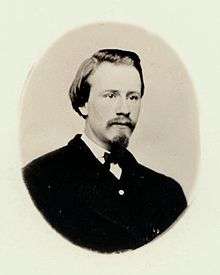John O'Fallon
| Born | 1791 |
|---|---|
| Died | December 17, 1865 |
| Allegiance |
|
| Service/branch |
|
| Years of service | 1812—1818 |
| Rank | Captain |
| Unit |
2nd Regiment of Riflemen Regiment of Riflemen |

John O'Fallon (1791 – December 17, 1865) was a businessman, philanthropist, and military officer. During the 19th century he rose to become the wealthiest person in St. Louis, Missouri.[1] He is the namesake of O'Fallon, Illinois, (incorporated in 1874) as well as O'Fallon, Missouri[2] and the nephew of William Clark.
In 1857, he donated over $1 million to establish the O'Fallon Institute at what is now Washington University in St. Louis.[3] O'Fallon's father, James O'Fallon, was a physician who served as a surgeon in Washington's army during the Revolutionary War. After the war he went to Louisville, Kentucky, married Frances Clark, a sister of George Rogers Clark and William Clark, Army officers, who became famous in exploring the Mississippi Valley. O'Fallon's father died while he was a child and he was raised by his mother. Following in his father's foot steps he fought in the War of 1812 where he rose to the rank of Captain.
After the war ended O'Fallon settled in St. Louis and became assistant Indian Agent to William Clark. O'Fallon then established a contracting business, buying and selling supplies to the Army, from which he accumulated wealth. He invested his newly acquired wealth in a number of very lucrative enterprises including railroads. He was one of the promoters of the Pacific Railroad (now Missouri Pacific) as well as the North Missouri Railroad (now the Wabash) and the Ohio and Mississippi (now Baltimore and Ohio) and was the first president of each of these railroads.
O'Fallon died on December 17, 1865 in St. Louis. He was buried in Bellefontaine Cemetery.
References
- ↑ http://www.ofallon.com/apex/ofal-bio.shtml
- ↑ Eaton, David Wolfe (1918). How Missouri Counties, Towns and Streams Were Named. The State Historical Society of Missouri. p. 356.
- ↑ Edited Appletons Encyclopedia, Copyright © 2001